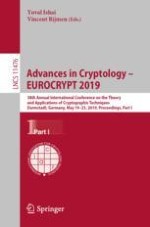2019 | OriginalPaper | Buchkapitel
Linear Equivalence of Block Ciphers with Partial Non-Linear Layers: Application to LowMC
verfasst von : Itai Dinur, Daniel Kales, Angela Promitzer, Sebastian Ramacher, Christian Rechberger
Erschienen in: Advances in Cryptology – EUROCRYPT 2019
Aktivieren Sie unsere intelligente Suche, um passende Fachinhalte oder Patente zu finden.
Wählen Sie Textabschnitte aus um mit Künstlicher Intelligenz passenden Patente zu finden. powered by
Markieren Sie Textabschnitte, um KI-gestützt weitere passende Inhalte zu finden. powered by
